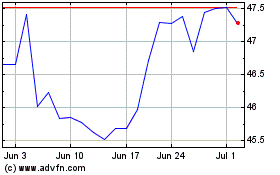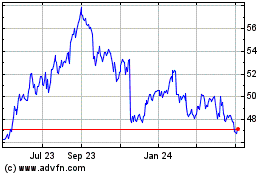Cisco Warns on Outlook As Challenges Mount Cisco Systems Inc. (CSCO) -- WSJ
November 17 2016 - 3:03AM
Dow Jones News
By Don Clark
Cisco Systems Inc. showed more signs of pressure on some of its
best-known networking hardware in the latest quarter, despite
growth in smaller businesses it entered more recently.
The big Silicon Valley company said first-quarter net income
fell 4.4%, largely because of restructuring charges, while revenue
declined 2.6%. Cisco projected that revenue would decline again in
the current period. Shares fell 4% in after-hours trading.
Cisco, based in San Jose, Calif., has long been a bellwether for
shifts in corporate technology spending. Chuck Robbins, the
company's chief executive, said Cisco's cautious outlook largely
was shaped by weak demand from communications-service providers and
the assumption that tepid economic conditions would continue.
"We are not going to model any improvement there," Mr. Robbins
said during a conference call, though he added that Donald Trump's
presidency could lead to more pro-business policies.
Cisco's charges in the first quarter largely stem from a plan
announced in August to shed 5,500 employees, 7% of its workforce --
in the latest of a series of responses to market shifts that
include customers opting for software and services over hardware.
The company said its head count fell by 1,326 during the quarter to
a total of 72,385.
Challenges facing Cisco include a preference among some web
companies and network operators to avoid big-name hardware vendors.
Some customers are choosing to run networking software on
inexpensive commodity-style switching systems from vendors such as
Taiwan's Quanta Computer Inc. Others are turning to external cloud
services rather than buying and managing their own computers and
networking devices.
Mr. Robbins cited other factors, including a reluctance by
customers to upgrade the switching gear used on corporate campuses.
Revenue from switching hardware, Cisco's largest business, declined
7%. Routing revenue rose 6%.
Mr. Robbins, who just completed his first year as chief
executive, has tried to shift Cisco's focus toward faster-growing
businesses built on software and services. Cisco said revenue from
its security business rose 11%.
Revenue from its collaboration segment, however, fell 3%, as
growth in services such as WebEx grew but sales of
videoconferencing gear slowed.
Cisco said its data center revenue, which includes sales of
server systems, declined 3%. Mr. Robbins said the company has been
affected as companies shift from hardware with its longtime blade
design -- with servers arrayed like books on a shelf -- to the more
common arrangement that resembles a stack of pizza boxes.
Sales of wireless gear, which had been growing lately, declined
5%.
In all, Cisco reported net income for the quarter ended Oct. 29
of $2.32 billion, or 46 cents a share, compared with profit in the
year-earlier period of $2.43 billion, or 48 cents. Revenue declined
to $12.35 billion from $12.68 billion.
Excluding restructuring charges and other one-time items, Cisco
put adjusted earnings per share at 61 cents. Analysts polled by
FactSet had projected earnings on that basis of 59 cents.
For the current period, Cisco projected adjusted profit of 55
cents to 57 cents a share and said revenue would fall 2% to 4%,
excluding the effects of a business in video delivery gear that was
divested in 2015. Analysts on that basis had projected earnings per
share of 59 cents on revenue of $12.16 billion.
--Nathan Becker contributed to this article.
Write to Don Clark at don.clark@wsj.com
(END) Dow Jones Newswires
November 17, 2016 02:48 ET (07:48 GMT)
Copyright (c) 2016 Dow Jones & Company, Inc.
Cisco Systems (NASDAQ:CSCO)
Historical Stock Chart
From Mar 2024 to Apr 2024

Cisco Systems (NASDAQ:CSCO)
Historical Stock Chart
From Apr 2023 to Apr 2024
